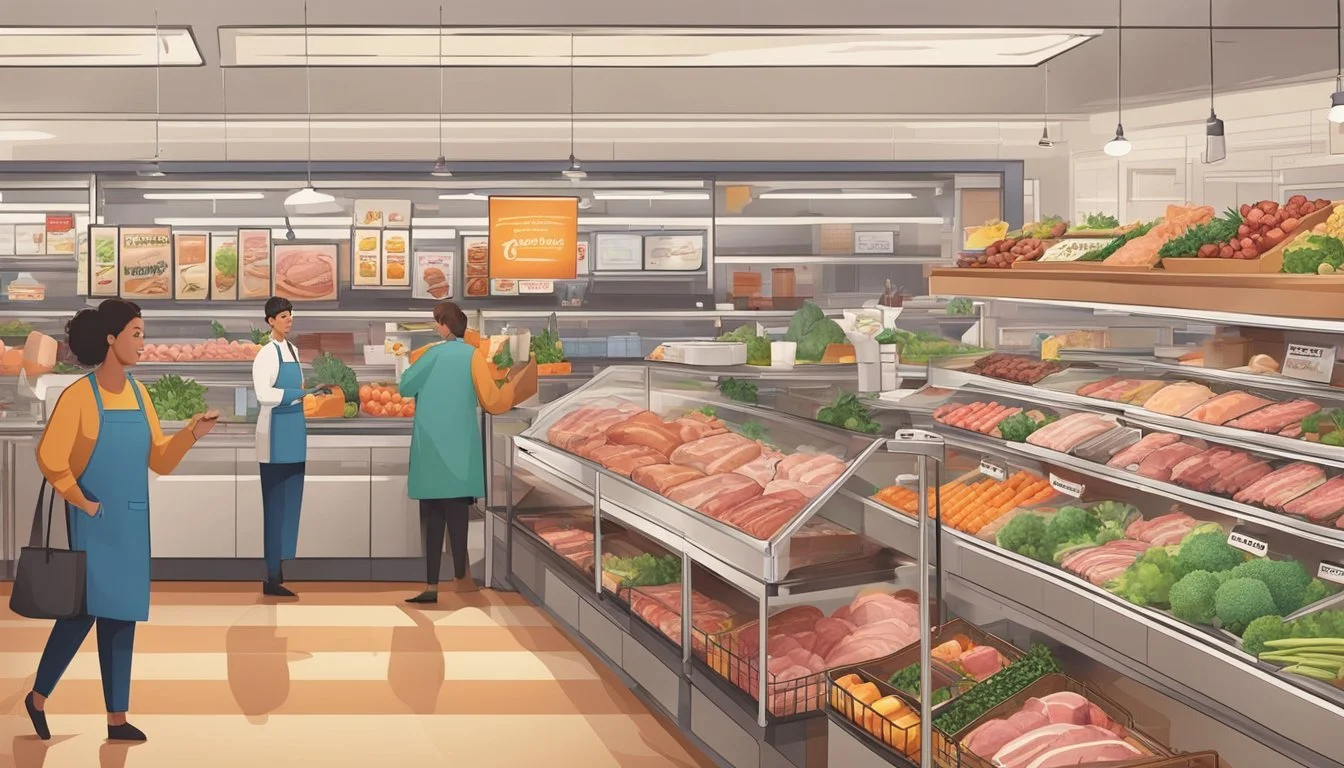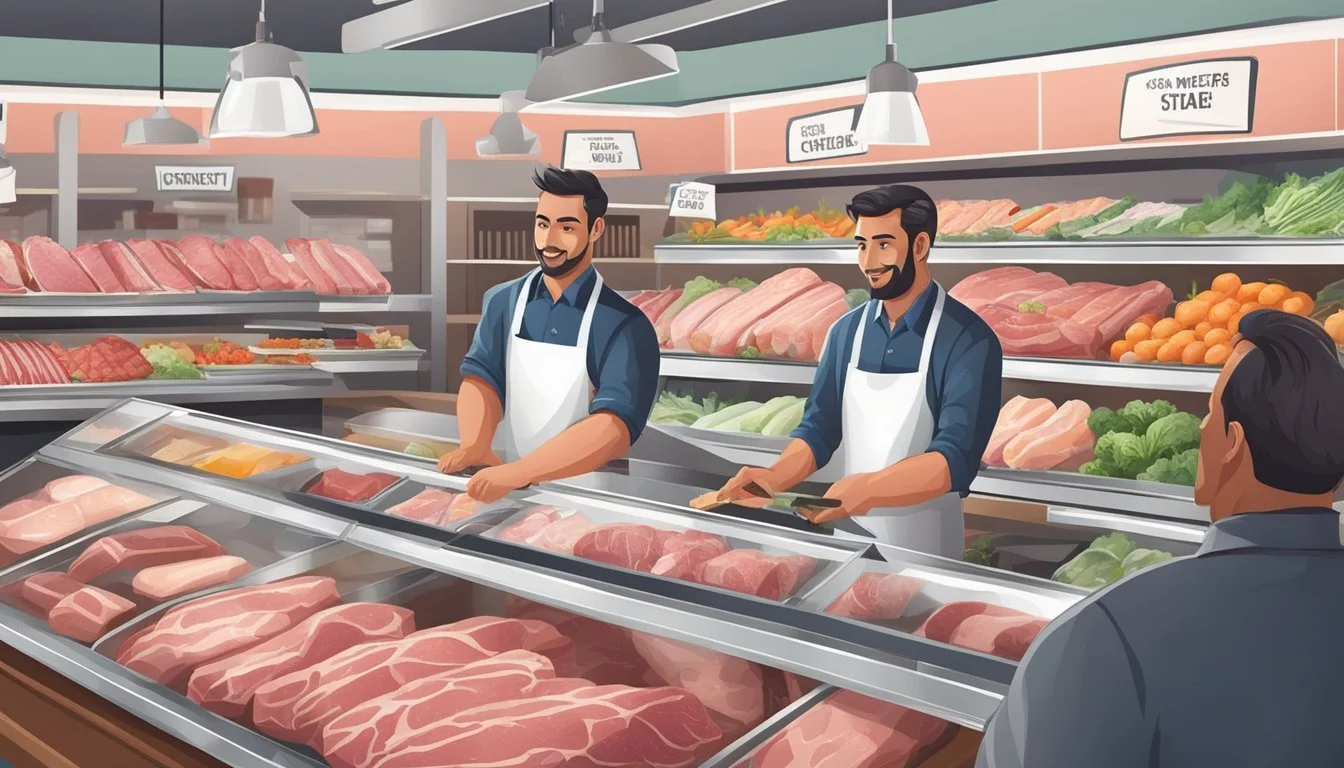Prime Cuts: Unveiling the Best Grocery Stores for Quality Meat
Choosing the right grocery store for purchasing meat can significantly impact the quality, taste, and nutritional value of your meals. With numerous options available, consumers often find themselves wondering which retailer offers the best selection and value for their money.
Whole Foods Market stands out as the top nationwide grocer for high-quality steaks and meat products. Their commitment to organic, grass-fed options and stringent animal welfare standards sets them apart from many competitors. While Whole Foods may come with a higher price tag, the superior taste and health benefits of their meat offerings justify the cost for many shoppers.
Other notable contenders in the meat department include Wegmans, known for its occasional prime beef offerings, and Costco, which provides good value for bulk purchases. Shoppers seeking quality meat should also consider local butchers and specialty meat markets, which often source from local farms and provide personalized service.
Understanding Meat Quality and Labels
Meat quality and labeling play crucial roles in making informed purchasing decisions at the grocery store. Consumers can rely on standardized rankings, packaging information, and animal welfare certifications to assess the quality and sourcing of meat products.
Significance of USDA Rankings
USDA Prime represents the highest quality grade for beef, followed by USDA Choice and USDA Select. Prime cuts have abundant marbling, ensuring tenderness and flavor. Choice beef offers high quality with less marbling than Prime. Select cuts are leaner but may lack some tenderness.
These rankings help consumers gauge the expected eating experience. Prime is ideal for special occasions, while Choice strikes a balance between quality and affordability. Select suits those preferring leaner options.
Decoding Meat Packaging Labels
Meat labels provide valuable information about the product's attributes and production methods. "Organic" indicates the animal was raised without synthetic pesticides or fertilizers. "Grass-fed" means the animal's diet consisted mainly of grass and forage.
"Antibiotic-free" signifies no antibiotics were used in raising the animal. "Hormone-free" indicates no added growth hormones were used. These labels help consumers align their purchases with their dietary preferences and values.
The Importance of Animal Welfare Standards
Animal welfare certifications reflect the conditions in which animals were raised. Labels like "Certified Humane" or "Animal Welfare Approved" indicate adherence to specific standards for housing, feeding, and handling.
These certifications assure consumers that the animals were treated ethically. They often correlate with better meat quality, as stress-free animals tend to produce superior meat. Ethical sourcing also addresses environmental concerns and supports sustainable farming practices.
Factors Affecting the Buying Decision
Consumers consider several key aspects when choosing where to purchase meat. These factors impact their overall satisfaction and likelihood of returning to a particular grocery store for future meat purchases.
Price Considerations
Meat prices vary significantly between grocery stores. Many shoppers prioritize finding the best deals and discounts. Some stores offer weekly specials or loyalty programs that provide additional savings on meat products.
Bulk purchases often come with lower per-pound prices, appealing to larger families or those who freeze portions for later use. However, premium cuts and organic options typically command higher prices across all retailers.
Shoppers may compare prices online or through store flyers before deciding where to buy. Some grocery chains match competitors' prices, giving budget-conscious consumers more options.
Convenience and Grocery Store Locations
Proximity to home or work plays a crucial role in meat-buying decisions. Consumers often prefer stores within a short driving distance or those easily accessible by public transportation.
Store layout and organization impact the shopping experience. Well-organized meat departments with clear labeling make selection easier and quicker.
Operating hours affect convenience. Stores with extended hours or those open 24/7 cater to diverse schedules and last-minute shopping needs.
Some grocery chains offer online ordering and curbside pickup, adding another layer of convenience for busy shoppers or those with mobility issues.
Consumer Reviews and Trust
Word-of-mouth recommendations and online reviews influence meat-buying choices. Positive experiences shared on social media or review sites can attract new customers to a grocery store's meat department.
Transparency in meat sourcing and quality standards builds trust. Stores that provide information about their suppliers and animal welfare practices appeal to conscientious consumers.
Customer service plays a role in building loyalty. Knowledgeable butchers who offer advice on cuts and preparation methods enhance the shopping experience.
Consistent quality and freshness of meat products contribute to a store's reputation. Negative experiences, such as spoiled meat or poor selection, can quickly erode trust and drive customers to competitors.
Selecting the Best Grocery Stores for Meat
When seeking high-quality meat, certain grocery stores stand out for their exceptional offerings and standards. The best options provide fresh cuts, diverse selections, and adherence to quality assurance practices.
Criteria for Quality Meat Sections
A top-tier meat department excels in several key areas. Freshness is paramount, with meats cut and packaged on-site daily. Variety matters too, offering a range of cuts from different animals.
Knowledgeable staff can guide customers and answer questions about sourcing and preparation. Cleanliness and proper storage are non-negotiable for food safety.
Transparency in labeling, including origin and farming practices, helps consumers make informed choices. Some stores go further by offering specialty items like dry-aged beef or house-made sausages.
Comparing Major Grocery Store Chains
Wegmans consistently ranks high for its meat quality and selection. Their meat counters offer prime cuts and knowledgeable butchers.
Costco provides excellent value for bulk purchases, with high-grade meats at competitive prices. Their prime beef is particularly well-regarded.
Whole Foods emphasizes organic and ethically sourced meats, using a 5-step animal welfare rating system. This appeals to health-conscious shoppers.
Publix is known for its fresh, high-quality meats and attentive customer service. They offer a good balance of conventional and organic options.
Walmart and Kroger provide affordable options but may not match the premium quality of specialized stores.
Specialty Grocery Stores and Organic Options
Specialty stores often excel in meat quality and unique offerings. Sprouts Farmers Market focuses on natural and organic meats, appealing to health-conscious consumers.
Trader Joe's offers a curated selection of meats, including pre-marinated options for convenience. Their organic and free-range choices are popular.
Local butcher shops, while not chains, often provide superior quality and personalized service. They may offer specialty cuts and locally sourced meats not found in larger stores.
Some regional chains like Stater Bros in California have built strong reputations for their meat departments, emphasizing quality and freshness.
Types of Meat Available
Grocery stores offer a diverse selection of meats to suit various tastes and dietary needs. From traditional options to more exotic choices, consumers can find a wide range of protein sources in the meat department.
Understanding Different Types of Beef
Beef is a staple in many households. Grocery stores typically stock various cuts, including ribeye, sirloin, and chuck roast. Prime beef, known for its superior marbling, is often available at higher-end stores. For budget-conscious shoppers, ground beef is a versatile option.
Some stores offer specialty beef like Wagyu or grass-fed varieties. These premium options cater to consumers seeking specific flavor profiles or production methods.
Beef grades, such as USDA Choice and Prime, indicate quality and tenderness. Many stores prominently display these grades to help customers make informed decisions.
Choosing Quality Poultry and Pork
Chicken remains a popular choice due to its versatility and affordability. Grocery stores usually stock whole chickens, breasts, thighs, and wings. Some offer organic or free-range options for health-conscious consumers.
Pork selections typically include chops, tenderloin, and ribs. Bacon and ham, derived from pork, are also common finds. Quality pork should have a pinkish-red color and minimal fat marbling.
Turkey is another poultry option, available year-round in many stores. It's often sold as whole birds or in parts like breasts and thighs.
Exploring Options Beyond Traditional Meats
Many grocery stores now offer alternative protein sources. Lamb, while less common than beef or pork, is gaining popularity. Cuts like chops and leg of lamb are often available.
Bison, also known as buffalo, is emerging as a leaner alternative to beef. It's typically sold as ground meat or steaks in specialty sections.
For adventurous eaters, some stores stock game meats like venison or duck. These options provide unique flavors and nutritional profiles.
Plant-based meat alternatives are increasingly common, catering to vegetarian and vegan customers. These products often mimic the taste and texture of traditional meats.
The Role of Suppliers and Local Farms
Suppliers and local farms play a crucial role in providing high-quality meat to grocery stores. Their practices and relationships with retailers directly impact the meat selection available to consumers.
Benefits of Sourcing Meat Locally
Local farms offer fresher meat with shorter transit times from farm to store. This results in better flavor and quality for customers. Many local farmers prioritize sustainable and ethical practices, raising animals on pasture or with higher welfare standards.
Buying from local suppliers supports the community economy. It keeps money circulating locally and helps preserve small family farms. Some grocery stores partner directly with nearby farms to offer exclusive products.
Local sourcing allows for greater transparency in the meat supply chain. Consumers can often trace their meat back to specific farms or even visit the source. This connection builds trust and allows shoppers to make more informed choices.
Understanding Supply Chain Transparency
Supply chain transparency is increasingly important to consumers. It involves knowing where meat comes from and how animals are raised. Some grocery stores now provide detailed information about their meat suppliers and farming practices.
Labels like "grass-fed" or "pasture-raised" give insight into animal diets and living conditions. However, these terms aren't always strictly regulated. Stores that work closely with suppliers can verify claims and ensure accuracy.
Transparent supply chains allow grocers to respond quickly to quality issues or recalls. They can trace products back to their source and address problems efficiently. This protects both consumers and the store's reputation.
Some retailers use technology to enhance transparency. QR codes on packaging may link to information about the farm or production methods. This empowers customers to make choices aligned with their values and preferences.
Preparation and Cooking of Meat
Proper meat selection and cooking techniques are crucial for achieving delicious results in the kitchen. Knowing how to choose quality cuts and prepare them optimally can elevate your culinary creations.
Selecting Tender Beef and Prime Cuts for Cooking
When choosing beef, look for cuts with good marbling - the white lines of fat running through the meat. This intramuscular fat contributes to flavor and tenderness. Prime grade beef offers the highest quality, followed by Choice and Select grades.
For steaks, ribeye, strip loin, and tenderloin are prized for their tenderness. Cuts from the loin and rib areas are generally more tender than those from the chuck or round.
Thickness matters too. Steaks cut 1-1.5 inches thick allow for better temperature control during cooking. Thinner cuts risk overcooking before developing a flavorful crust.
Specialty Products: Dry-Aged and Wagyu
Dry-aged beef undergoes a process that enhances flavor and tenderness. During aging, moisture evaporates, concentrating the meat's flavor. Enzymes also break down muscle fibers, increasing tenderness.
Wagyu beef, known for its intense marbling, offers a rich, buttery texture. Japanese A5 Wagyu represents the highest grade, but American Wagyu crosses are more widely available and still deliver excellent taste.
These specialty meats often command higher prices but can provide a luxurious dining experience for special occasions.
Cooking Techniques for Optimal Taste
For tender cuts like ribeye or filet mignon, high-heat methods work well. Pan-searing or grilling creates a flavorful crust while maintaining a juicy interior.
Cooking tips:
Let meat come to room temperature before cooking
Season generously with salt and pepper
Use a meat thermometer for precise doneness
For tougher cuts like brisket or chuck roast, low and slow cooking methods are best. Braising or slow-roasting breaks down connective tissues, resulting in tender, flavorful meat.
Resting meat after cooking is crucial. This allows juices to redistribute, ensuring a moist and flavorful result.
Exploring Added Values and Services
Many grocery stores offer additional services and value-added options in their meat departments. These features can enhance the shopping experience and provide convenient solutions for customers.
The Convenience of Pre-Prepared Meat Options
Pre-prepared meat options save time and effort for busy shoppers. Many stores offer marinated meats, seasoned cuts, and ready-to-cook items. These products often come in portion-controlled sizes for easy meal planning.
Some popular pre-prepared options include pre-formed burger patties, kebabs, and stuffed chicken breasts. These items are typically priced slightly higher than raw cuts but can be worth the convenience for many customers.
Stores may also offer pre-cooked options like rotisserie chickens or sliced deli meats. These ready-to-eat items provide quick meal solutions for shoppers on the go.
Additional Services in Butcher Departments
Butcher departments in grocery stores often provide extra services to enhance the customer experience. Many offer custom cuts of meat to exact specifications requested by shoppers.
Free meat grinding is a common service, allowing customers to choose their preferred cuts for ground beef or other meats. Some stores also offer meat tenderizing at no additional cost.
Knowledgeable butchers can provide cooking tips and recipe suggestions. This personalized service adds value to the shopping experience and helps customers make informed choices.
Special orders for large quantities or specific cuts are often available with advance notice. This service is particularly useful for customers planning events or special meals.
Tips for Consumers
Equipping yourself with knowledge and avoiding common pitfalls can significantly improve your meat-buying experience. These strategies will help you make informed decisions and get the best value for your money.
Building Knowledge for Better Purchases
Learn to identify quality cuts of meat. Look for marbling in beef, which indicates tenderness and flavor. For chicken, check for plump breasts and avoid any with discoloration. Pork should have a pinkish-red color with some marbling.
Familiarize yourself with different grades of meat. USDA Prime is the highest quality, followed by Choice and Select. These grades primarily apply to beef but can guide your purchases.
Understand pricing strategies. Sometimes, frozen meat offers better value without sacrificing quality. Compare prices per pound rather than package prices.
Ask the butcher for advice. They can provide tips on preparation methods and suggest alternatives for your recipes.
Avoiding Common Buying Mistakes
Don't be swayed by appearance alone. Bright red beef isn't always fresher; it may have been exposed to oxygen to enhance color.
Avoid purchasing pre-marinated meats. These often mask lower quality cuts and can be high in sodium.
Check expiration dates carefully. "Sell by" dates are different from "use by" dates. Plan your meals accordingly.
Be wary of unusually low prices. They might indicate lower quality or meat nearing its expiration date.
Don't shy away from less popular cuts. They can offer great value and flavor when prepared correctly.
Consider buying in bulk and freezing portions. This can save money in the long run, especially for frequently used cuts.
Alternative Considerations
When exploring meat options at grocery stores, some consumers seek plant-based alternatives or prioritize animal welfare. These factors can significantly influence purchasing decisions and store preferences.
Meat Alternatives for Vegetarian Diets
Many grocery stores now offer extensive selections of meat alternatives to cater to vegetarian diets. Popular options include tofu, tempeh, seitan, and plant-based burgers made from ingredients like pea protein or soy.
Some stores dedicate entire sections to vegetarian products, making it easier for customers to find alternatives. These items often mimic the taste and texture of meat while providing protein and nutrients.
Specialty stores may carry a wider range of meat substitutes, including lesser-known options like jackfruit or mushroom-based products. As demand grows, even traditional supermarkets are expanding their vegetarian offerings.
Understanding Food Animal Welfare
Food animal welfare is an increasingly important consideration for many consumers when choosing where to buy meat. Some grocery stores prioritize sourcing from farms with higher animal welfare standards.
Cage-free eggs have become more common, with many stores phasing out eggs from hens kept in battery cages. Free-range and pasture-raised options are also gaining popularity.
For meat products, labels like "grass-fed," "free-range," or "humanely raised" indicate higher welfare standards. Some stores work directly with local farms to ensure transparency in animal treatment.
Consumers can research a store's animal welfare policies or look for third-party certifications on packaging to make informed choices. These considerations often influence both product selection and pricing.





